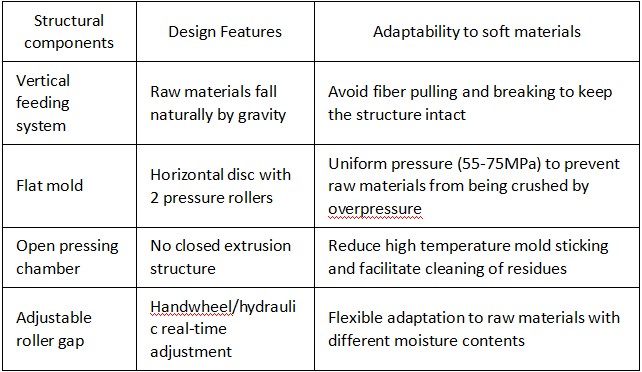BLOG
| Subscribe to our e-mail can be Downloads Free buyer's guide! |
2025-09-24 15:55:30 hits:299
Analysis of the Core Structure of the Flat Die Pellet Mill: Why is it Ideal for Soft Feedstocks?
The following is an in-depth analysis of its structural principles and feedstock compatibility:
I. Core Structural Advantages

II. Why is it Ideal for Soft Feedstocks?
Fiber Protection Mechanism
o Ring Die Disadvantages: The forced propulsion of the spiral tears the fibers, easily crushing straw-like feedstock into powder.
o Flat die solution: Vertical gravity feed + gentle kneading with a pressure roller maintains the toughness of straw, alfalfa, and improves the forming rate by 20%.
Anti-blocking design
o The open structure allows large fibers (Ōēż15mm) to pass through, while ring die machines require the raw materials to be crushed to Ōēż8mm.
o Actual measurements show that when processing peanut shells, the blockage frequency of flat die machines is 80% lower than that of ring die machines.
III. Upgrade Solution: Enhanced Soft Material Handling Capability
1. Optimized pressure roller texture:
o Use a shallow grooved patterned pressure roller to increase friction with the raw material and prevent slippage.
2. Increased die aperture ratio:
o Increase the number of die holes to 35-40 holes/100cm┬▓ (conventional: 25 holes) to accelerate discharge.
3. Add anti-entanglement device:
o Install a rotating fork at the feed inlet to break up long fiber entanglements.
Conclusion
With its structural characteristics of soft compression, moisture tolerance, and anti-entanglement, the flat die pelletizer is the optimal solution for pelletizing soft raw materials. For scenarios such as straw recycling and feed processing, choosing a flat die machine can significantly reduce energy consumption and raw material loss, and achieve efficient production!